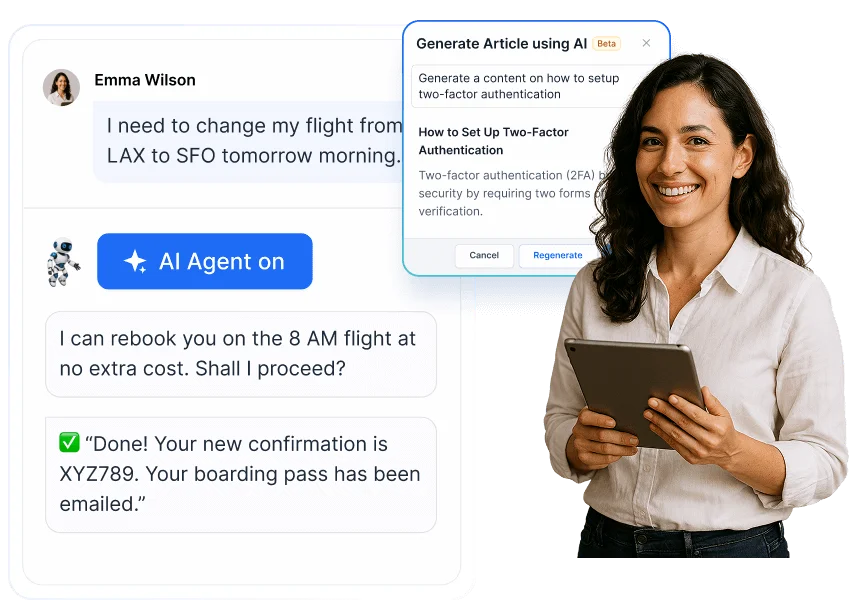Saying no to customers’ requests can be quite unpleasant for company employees. The fear of potentially ruining the customer relationship and the threat of customer churn are situations that customer service teams never look forward to.
But to be honest, as much as we strive to meet the needs of every client, agreeing to every request is simply not realistic.
It might be a request beyond our capabilities, a deadline that is too tight to meet, or a product that just isn’t ready yet.
In such cases, knowing how to say no to customers in a polite way is what may save you from losing the customer.
This blog shares tips on how to decline customer requests without offending them.
7 Tips on how to say no to customers
Turning down a customer’s request might appear to conflict with a customer-centric approach required to maintain a competitive advantage.
Getting bogged down with requests that are beyond the scope of your SLA and support team’s capabilities decreases the quality of your customer service overall, though.
Here are some best practices for saying no to customers’ requests while maintaining a positive relationship.
| Scenario | Example |
| Acknowledge and appreciate customers’ requests | Thank you for writing to us about this. We truly appreciate the opportunity to understand your needs better. |
| Decline in an empathetic tone | We understand how important this is to you, and I genuinely wish we could help.
Regrettably, we’re unable to fulfill your request at this time. |
| Be honest about why you cannot fulfill customer requests | We understand how important integrated chat support is for your workflow.
Unfortunately, due to current development priorities, we’re unable to implement the feature soon. |
| Suggest alternative solutions to the issue | The advanced analytics and reporting feature is only available in our higher-tier pricing plan.
If upgrading isn’t an option, let us show you how you can maximize your current plan with the existing analytics features. |
| Communicate your thoughts positively | Thank you for sharing your idea!
While we cannot implement your request now, we have noted your suggestion and will consider it for future updates. |
| Ask for feedback from the customers | Thanks for reaching out!
Though we are unable to accommodate your request now, we’d greatly value your input on ways to enhance our services. Would you mind taking a quick survey? |
| Follow through with the client | I wanted to get in touch following our recent conversation where we were unable to fulfill your request.
I’m here to discuss alternative solutions or address further concerns you may have. Please feel free to reach out if we can help with anything else. |
Acknowledge and appreciate customers’ requests
Begin your response by expressing gratitude to the client for coming to you with the issue. Leading with a sincere thank you establishes a respectful tone for your communication.
It shows the client that their input is important to you and that you take their concerns seriously. This approach also softens the blow when you eventually communicate the refusal.
Decline in an empathetic tone
Customers don’t exist solely as problems to be solved. They have motivations, hopes, and sometimes disappointments tied to their requests.
59% of all consumers feel companies have lost touch with the human element of customer experience -Pwc
Display empathy and understanding when saying no to customers to preserve a positive relationship. This also ensures that the rejection is received as a respectful and considerate decision.

Practicing empathy in customer service is acknowledging the clients’ feelings and perspective, which can play a big part in easing frustration or disappointment.
Be honest about why you cannot fulfill customer requests
Honesty is a key customer communication strategy that maintains transparency and builds trust.
When you’re straightforward with customers about the limitations or reasons behind your decision, they’re more likely to understand and accept the refusal without feeling misled or dismissed.
Providing a genuine explanation can make way for alternative solutions, as customers may be more open to discussing different options that could ameliorate their issue.

Honesty also sets realistic expectations for future customer interactions, reducing the likelihood of misunderstandings, potential frustration, or dissatisfaction.
Suggest alternative solutions to the issue
Even though you can’t fulfill their exact request, offering customers other options when possible shows your commitment to their satisfaction.
You’re not simply dismissing them but actively trying to find another way to satisfy them.
By providing alternatives, you turn a negative response into a more constructive one, which can lessen disappointment and promote repeat business.
Besides, it can also lead to discovering new solutions that might be even better suited to the customer’s needs.
Communicate your thoughts positively
Using positive language when saying no to customers maintains a constructive and supportive interaction, even in the face of disappointment.
Positive language focuses on what can be done rather than what cannot, which helps to keep the conversation solution-oriented.

Even though their initial request wasn’t met, a friendly attitude can help preserve the relationship with the customer.
Ask for feedback from the customers
Apart from assuring your customers that you value their opinions, collecting customer feedback will also let you understand the reasons behind your customer’s need for a product or service that was beyond your ability to provide.
Customer feedback surveys may reveal your customers’ priorities, guiding product development.
Follow through with the client
If appropriate, keep in touch with the customer after you decline their request to maintain a positive relationship and demonstrate excellent customer service.
This shows that the company is committed to ongoing support and conveys to the customer that their concerns remain a priority for the business despite the inability to fulfill the original request.
This follow-up can take various forms, such as offering alternative solutions, gathering feedback, or simply checking in to ensure the customer feels heard and valued.
Practical examples of when to say no to customers
While it’s tempting to always say yes to keep customers happy, there are circumstances where saying no to customers is the best course of action for both you and your client.
When the request goes against company policy or ethical standards
Sometimes, fulfilling a customer request may mean violating your core values and policies.
For example, if a customer asks you to lie, cheat, or break the law, you should refuse to do so.
Explain to them how processing their request goes against your policies without making any kind of value judgment.
When the request is beyond your scope of expertise
Sometimes, customers have expectations that simply can’t be met. It could be a deadline that is impossible or a feature that would require you to significantly alter your product.
Saying no to customers and being honest about your limitations is key in such situations.
When the request would harm your business
Certain requests, like offering unfair discounts or compromising the product quality, might damage your reputation or financial stability.
Saying no to customers helps maintain integrity and protects your financial stability.
When the customer is abusive or disrespectful
No one deserves to be treated poorly. If a customer becomes rude, abusive, or aggressive, you have the right to protect yourself and your team.
This could mean saying no to them or even cutting off communication completely.
Say no to customers while maintaining positive relationships
Managing customer expectations can often be challenging, particularly when they make requests beyond your capacity to fulfill. The delicate task of saying no to customers without losing them is a common dilemma for businesses.
However, we hope the strategies shared in this blog will help guide you in respectfully and professionally declining.
BoldDesk empowers you to communicate effectively with customers to create an environment that encourages future business. Contact us to arrange a live demo and experience how our features can enable you to swiftly navigate through service issues and enhance your customer connections. Or, sign up for our 15-day free trial to try it for yourself.
Do you have any other suggestions on how to say no to customers? Please share your feedback in the comments section below.



















 Email Ticketing System
Email Ticketing System Shared Inbox Software
Shared Inbox Software Multi Brand Help Desk
Multi Brand Help Desk Internal Help Desk Software
Internal Help Desk Software Trouble Ticketing Software
Trouble Ticketing Software Mobile Help Desk
Mobile Help Desk 

















